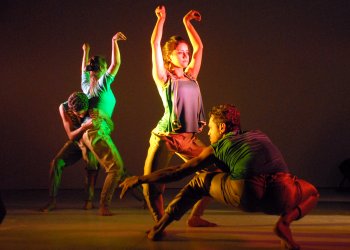
|   |

|   |
Parivahitam: Perspectives in Motion - Nita Vidyarthi, Kolkata e-mail: drnitav@rediffmail.com February 14, 2011 Premiered in New York to critical acclaim on 13th July 2010 as a part of the Global Dance Meet 2010 organised by World Dance Alliance, Americas, Kolkata's Sapphire Creations toured the major cities of India with their latest highly charged Indo-Swiss production Parivahitam, the final shows being at Swissotel to a select audience on the 11th of January 2011 and at the Rabindranath Tagore Centre, ICCR, Kolkata on the 12th respectively. Sudarshan Chakravarty a talented and versatile dancer and artistic director who spearheads Sapphire Creations, has taken the organisation from strength to strength together with co-director Paramita Saha, an exhaustively trained contemporary dancer in her own right, to make it Eastern India's only experimental dance company, striving to develop an organic, radical and alternative idiom of movement. The presentation was conceived as a cross-journey between an ordered, disciplined and beautiful past and a chaotic, atomised and unhinged present. To make a choice of the quality of life is not always in one's control and moments of stillness (movements without music) and activity (with dynamic dances) were the theme knit into music live by Marc Rossier from Bern. He used a sound device and loop station with various loops. The present was a moment of much concern by the dancers as was the freedom of their solos, their expressions all different, being performed simultaneously by all the dancers into a well knit duet or a trio or a group. The title of the production was taken from an ancient Indian Shiroveda that describes the movement of the head in the form of a ripple, in circular motion from side to side facilitating complete vision of the surroundings from all perspectives and throughout the presentation, this head movement played an important role to emphasise the theme. The challenge of idea was trying. It was abstract based on feelings and moods on any one striking moment that had made the difference in the lives of the dancers which they then refined after filtering them a number of times, till the birth of an expressive form, a movement. Most of the solos were thus composed.   Curiosity due to the form as well as the narrative was sought by swirls on the floor by Ankita, sways by Kaushik, a few acrobatic movements, the lines of movement, vertical and then horizontal often in entangled forms in a duet to display contact improvisation with construction and then deconstruction of movements, entirely architectural. This was especially the case with the agony displayed by Paramita, the lead female dancer as well as Dibyendu, the principal dancer. The final ecstatic moment of completeness of love and satisfaction was achieved with strong leaps and movements, showing of the ankles and legs to the best advantage. The style in the one hour performance was more free in form and did not adhere to strict rules of movement and a tighter discipline. There was richness in parts but that did not predominate, the content did. The language was not always recognizable. Happiness or beautiful states of life were concrete, clear but not the scattered mental situations or discomfort. The negative emotions and the state of mind were not always possible to distinguish or interpret or perhaps left open by the director to the individuals! And that is perhaps what Parivahitam is all about - to bring on stage the contemporary life, the contemporary situations and experiences visually through contemporary movements. There were glimpses of lovely lifts, foot-tapping (No, not Tap dance) steps with the strumming of guitar and a riot of colours, beautiful costumes (designed by Sayatan Sarkar) also fruity ones of peach, mango, leaves and flowers and interesting, colourful pen-sketches. The intense interesting production initiates a thought process in the spectators by choreographic and artistic director, (also the concept) Sudarshan Chakravarty and Paramita Saha, together with choreographic collaborators Roger Sinha (Canada), Christopher Lechner (Germany) with text extracts from Sylvia Plath and light design by Chandan Sen. |